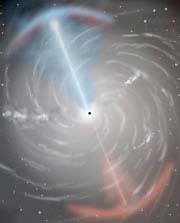Movie of a galaxy far, far away

An artist’s impression of the core of NGC 1068 as seen from earth. <br>© Gemini Observatory <br>
Astronomers shoot first film of the stars, dust and gas at the centre of a galaxy.
Astronomers have made their first movie of the roiling mass of stars, dust and gas at the centre of a galaxy.
The movie zooms into the disk of saucer-shaped galaxy NGC 1068 and through its super-bright core. It reveals an energetic region of space created by material flying out of the suspected black hole at the centre and crashing back into the disk. This region appears as a pale blue cloud far from the centre.
“You can see the distribution of matter and how it’s moving, across the whole galaxy,” says one of the team, Roger Davies at the University of Durham, UK.
Davis and colleagues stared into the heavens with a device like an insect’s compound eye, called the Integral Field Unit (IFU). They attached this to the Gemini North telescope in Hawaii (GMOS) and pointed the combination at NGC 1068, a galaxy 70 million light years away in the constellation Cetus, the whale.
The movement of matter at the heart of galaxies is crucial to understanding how they work. “We need to measure the mass of what’s in the middle,” says Davies. Most are thought to harbour black holes there. The speed of stuff spinning around should show how much galaxies weigh, and how much energy escapes or goes into making stars.
Wide shot
The same galaxy was recently studied with the Hubble space telescope1. But Hubble can only record how matter is moving along a very narrow slice of a galaxy – albeit at very high resolution.
Hubble sees where matter is by measuring the brightness of light along a slit. The light’s wavelengths can also tell astronomers whether the matter producing the light is moving towards or away from us.
GMOS coupled with IFU uses this same technique but over a whole galaxy. “Large ground-based telescopes like Gemini are the perfect complement to Hubble because they collect so much more light,” says Gerald Cecil, an astronomer at the University of North Carolina in Chapel Hill who carried out the Hubble measurements.
An image of the galaxy from the Gemini telescope is focused on an array of fibre-optic cables thinner than a human hair. Each of these records a slit of light from part of the image. Combining these gives a series of three-dimensional pictures from which an animation can be constructed.
References
- Cecil, G. et al. Spatial Resolution of High-Velocity Filaments in the Narrow-Line Region of NGC 1068: Associated Absorbers Caught in Emission?. Astrophysical Journal, In the press (2002).
Media Contact
All latest news from the category: Physics and Astronomy
This area deals with the fundamental laws and building blocks of nature and how they interact, the properties and the behavior of matter, and research into space and time and their structures.
innovations-report provides in-depth reports and articles on subjects such as astrophysics, laser technologies, nuclear, quantum, particle and solid-state physics, nanotechnologies, planetary research and findings (Mars, Venus) and developments related to the Hubble Telescope.
Newest articles

First-of-its-kind study uses remote sensing to monitor plastic debris in rivers and lakes
Remote sensing creates a cost-effective solution to monitoring plastic pollution. A first-of-its-kind study from researchers at the University of Minnesota Twin Cities shows how remote sensing can help monitor and…

Laser-based artificial neuron mimics nerve cell functions at lightning speed
With a processing speed a billion times faster than nature, chip-based laser neuron could help advance AI tasks such as pattern recognition and sequence prediction. Researchers have developed a laser-based…

Optimising the processing of plastic waste
Just one look in the yellow bin reveals a colourful jumble of different types of plastic. However, the purer and more uniform plastic waste is, the easier it is to…


